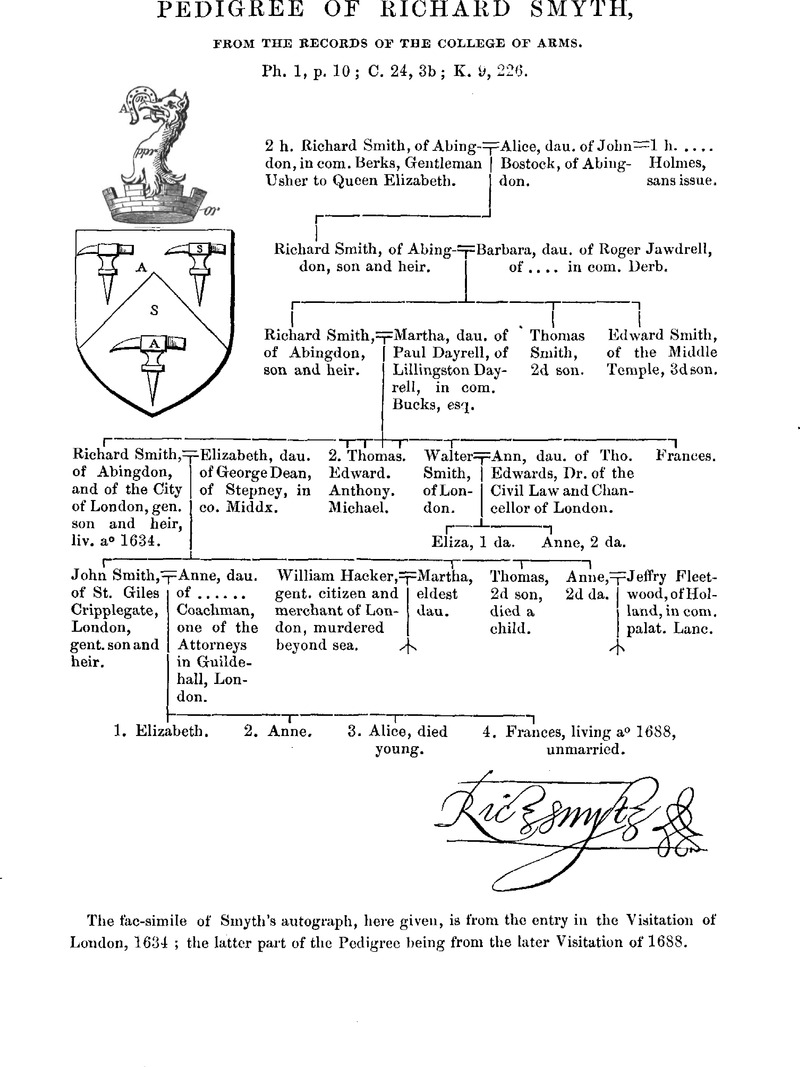No CrossRef data available.
Article contents
A Catalogue of all such persons deceased whome I knew in their life time, wherein are set down the several years of Our Lord, and the dayes of the month when every one of them dyed or were buried, from the year of Our Lord M.DC.XXVIII. successively
Published online by Cambridge University Press: 23 February 2010
Abstract

- Type
- Obituary of Richard Smyth
- Information
- Copyright
- Copyright © Royal Historical Society 1849
References
page 7 note a Thavies Inn —ED.
page 25 note a Chalmers says he died on Jan. 7th.—ED.
page 25 note b Baulmes, or Balmes House, formerly in Shoreditch parish, but now in Hackney. The seat of the Welds, and afterwards of Sir George Whitmore, who died there in 1654.—ED.
page 33 note * This was John Greaves, best known as a mathematician, and as the author of “Pyramidologia, or a Description of the Pyramids of Egypt.” 8vo. Lond. 1646.
page 36 note * He was sequestered from his vicarage, by a Committee of the House of Commons, in 1642.—ED.
page 37 note * Butler records his name in Hudibras,
“There was an ancient sage Philosopher
Who had read Alexander Ross over.”
Evelyn, in his Diary, says, “1649, July 11, came to me old Alexander Rosse, the divine, historian, and poet.”—ED.
page 42 note a This was John Hales, usually distinguished by the appellation of “the ever memorable.” Chalmers says “he was buried according to his own desire in Eton church-yard, where a monument was erected over his grave by Mr. Peter Curwan.”—ED.
page 44 note a Dr. William Harvey, who first discovered the circulation of the blood.—ED.
page 45 note a Four thousand persons are said to have attended his burial.—ED.
page 50 note a In the street now called Liverpool Street, but then designated Bedlam Street, and subsequently Old Bedlam, the street leading to the site of the antient Hospital. See another entry in p. 53, and again p. 56.—ED.
page 51 note a See Granger, vol. ii. p. 407, for her character.
page 54 note a Cranford.—ED.
page 56 note a The title of a Pamphlet published at this time may be worth adding. “The Way to be rich, according to the practice of the Great Audley, who begun with two hundred pound, in the year 1605, and dyed worth four hundred thousand pound this instant November 1662. Rem quoamque modo Rem.” 4to. Lond. 1662. Audley's Christian name does not appear throughout this pamphlet.—ED.
page 58 note a Henry Lucas, Esq. was the founder of the Lucasian professorship at Cambridge. His books were not bequeathed to any College, but to the Library of the University, “to supply as far as he could the loss occasioned by the removal of the Lambeth Library.” See the Preface to Dr. Barrow's Mathematical Lectures, and Ackerman's History of the University of Cambridge, vol. ii. p. 142.—ED.
page 61 note a Canonbury.—ED.
page 71 note a This was George Thomason, who formed the singular Collection of Books, Tracts, and single Sheets, from 1640 to 1660, now preserved in the British Museum, and known by the name of “The King's Pamphlets.” They were purchased and presented to the British Museum by His Majesty King Geo. III. in 1762.—ED.
page 76 note a Hugh Lord Coleraine. He was buried at Totteridge, Oct. 9.—ED.
page 78 note a He is called Pretest in p. 76.—ED.
page 80 note a The word maker omitted.—ED.




